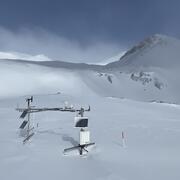USGS scientist measures streamflow on Middle Fork Ranch Creek, CO
USGS scientist measures streamflow on Middle Fork Ranch Creek, COUSGS scientist John Fulton measures streamflow on Middle Fork Ranch Creek, Colorado using instream, conventional methods. USGS radar equipment is also shown recording non-contact river discharge.







